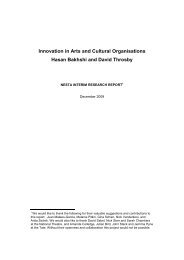Rumbling on performativity_Frits Simon
Rumbling on performativity_Frits Simon
Rumbling on performativity_Frits Simon
Create successful ePaper yourself
Turn your PDF publications into a flip-book with our unique Google optimized e-Paper software.
issues evolve out of social interacti<strong>on</strong>s, a portrait of self-organizati<strong>on</strong>. Especially in<br />
chapter 3 I elaborated <strong>on</strong> that in regard of the internal branding programme. Another<br />
of these noti<strong>on</strong>s within complexity is about time; a different perspective <strong>on</strong> what time<br />
is that provokes another percepti<strong>on</strong> <strong>on</strong> what happened during the project.<br />
Some reflecti<strong>on</strong>s <strong>on</strong> time<br />
Normally our efforts would have led to c<strong>on</strong>clusi<strong>on</strong>s and to planned acti<strong>on</strong>s. But it did<br />
not and if I had suggested that there were some sort of measurable results, I would<br />
have c<strong>on</strong>cealed my feelings of indecisiveness. Moreover, I would have passed the<br />
c<strong>on</strong>fusi<strong>on</strong> of at least <strong>on</strong>e of the participants, and maybe passed the c<strong>on</strong>fusi<strong>on</strong> of my<br />
readers because my narrative stops in the middle of nowhere. C<strong>on</strong>clusi<strong>on</strong>s and planned<br />
acti<strong>on</strong>s would have suggested that we understood what we did and we could<br />
bring a first phase of this project to an end.<br />
We are used that there is a beginning and an end of a project which are played off<br />
within a certain time. At the beginning we normally define a starting point, at the end<br />
we expect to have a soluti<strong>on</strong>. What we mostly forget is that both the beginning and<br />
the end are created as and create isolated moments in <strong>on</strong>going processes. Deeply<br />
ingrained is that time is a measurable quantity, which is directly c<strong>on</strong>nected to the idea<br />
that within a certain amount of time we are able to plan and finish things. This quantified<br />
or productive idea of time bel<strong>on</strong>gs to us as a sec<strong>on</strong>d nature, although it is ‘<strong>on</strong>ly’ a<br />
specific c<strong>on</strong>straint within our minds as evolved in western civilized society (Elias, 1982).<br />
This productive idea of time is different from the experience of time as we have in our<br />
everyday acti<strong>on</strong>s and is different from how the discussi<strong>on</strong>s around dissent actually<br />
evolved.<br />
One of the participants in the think-tank more than <strong>on</strong>ce asked me if the discussi<strong>on</strong>s<br />
in the think-tank had brought me what I wanted. My answer was that I did not have<br />
specific targets <strong>on</strong> my mind, neither regarding the subject of dissent nor the outcomes<br />
of the discussi<strong>on</strong>s. A better answer would have been that my targets or outcomes<br />
changed in due time of the discussi<strong>on</strong>s, even the idea that this was a useable project.<br />
Starting with the idea of being appointed as a corporate jester or as a Corporate<br />
Critical Friend, next to stimulate organizati<strong>on</strong>al reflexivity, proceeding with enabling<br />
dissenting opini<strong>on</strong>s and as yet ending with dissent shows the way my targets moved.<br />
Somehow I had plunged into these discussi<strong>on</strong>s and to what they would lead became<br />
undetermined. At the same time I struggled with this vagueness, socially c<strong>on</strong>diti<strong>on</strong>ed<br />
by the assumpti<strong>on</strong>s that efforts will have to lead to something c<strong>on</strong>crete and that my<br />
principals expect measurable results. My colleague who asked me for the results<br />
probably acted within the same habitus, from her part even with the expectati<strong>on</strong> that<br />
I was developing a model for dissenting communicati<strong>on</strong>. To support me she pointed<br />
me to a model of upward management, inspired by CMS (Hetebrij, 2006).<br />
In due course my most important intenti<strong>on</strong> became to advance an open-ended discussi<strong>on</strong><br />
c<strong>on</strong>cerning dissent. Partly because I understood that this was a touchy sub-<br />
6. A case of c<strong>on</strong>sent about dissent | 167



